Remembrances
With Padre Kino on the Trail
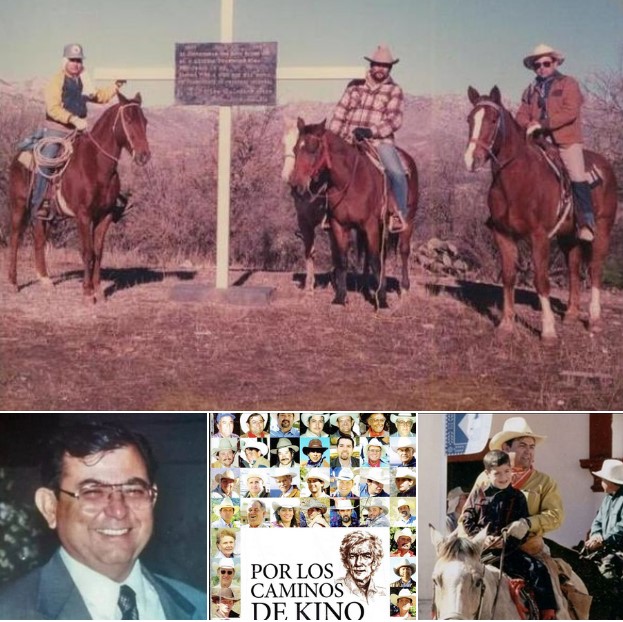
Jesus Enrique Salgado Bojórquez (1946-2022)
April 3, 2020
JESUS ENRIQUE SALGADO BOJÓRQUEZ (1946-2022). The Kino Community Mourns This Great Man's Death and Remembers His Life - Key Promoter of Kino's Sainthood, Founder of Kino Cabalgatas, Community and Business Leader of Sonora. "Si se pudiera describir a Enrique Salgado en una sola palabra, yo dijera INTEGRIDAD." (If you could described Enrique Salgado in one word, it would be INTEGRITY). On the news of his death last week after a long illness, many more people would write in similar way describing Enrique and how he lived his life.
Like Padre Kino, Enrique was a man of great moral and physical courage. He also was a man of generosity, hope and vision who stroved to better Sonora and its people that he loved and sacrificed so much for. Enrique's funeral Mass was on the anniversary of Kino's death as determined by the Catholic liturgical calendar. Kino died on the movable calendar Sunday of Laetare Sunday (4th Sunday of Lent). The theme of Laetare Sunday is hope and joy - a very different emphasis than the season of Lent's general observance as a time reflection and repentance. Laetare Sunday was an appropriate time for both Enrique and Padre Kino to depart from us since they were men with great hope and joy for life.
The Kino Community living outside of Mexico primarily knew Enrique for his Kino activities and as a devoted family man. Of course there was much more to his life that you can read below in this post.
Enrique in 1987 founded and led the Kino Cabalgatas. For 30 years Enrique's family, friends and Kino aficionados would annually ride for over 30 years the trails of Kino on a pilgrimage on horseback in honor of our heroic padre. These "living history" Kino Cabalgatas by Los Caminos de Kino were physically grueling 3 to 4 day trips on horseback through some of the harshest of mountain and desert environments in the states of Sonora, the Baja Californias, Sinaloa and Arizona. Most of the rides would average 20 miles per day on rugged trails.
Enrique and his brother wrote about the cabalgatas from 1987 to 2010 in their book "Por Los Caminos de Kino." Also Enrique is interviewed in 2011 on an online video with route maps and pictures at https://www.youtube.com/watch?v=bmjfgk-2pQE
The Kino Cabalgatas after 2010 are written about in the book by Southern Arizona rancher and environmental scientist Richard C. Collins in "Riding Behind The Padre: Horseback Views From Both Sides of the Border." Richard's book, originally written in English, is translated in Italian and Spanish with a dedication to Enrique. More about the book at https://www.richardccollins.com/riding-index
More about the Kino Cabalgatas online with maps of the routes at https://padrekino.com/index.php/khs_home/kino-heritage/kino-cabalgatas-section-page-caminos-de-kino
Enrique also was a key person in the promoting the sainthood cause of Padre Kino and its reaching the second sainthood stage by Kino being name venerable in August 2020. Enrique with others collected and delivered to the Vatican in 2006 over 150 pounds of documentation in support of Padre Kino's sainthood cause. Enrique's leadership in the early 2000s made this happened after 20 years of stops and starts. Kino's sainthood cause was begun when Kino's skeletal remains were found in Magdalena in 1967. More about Enrique and Kino's sainthood cause at http://www.padrekino.com/index.php/khs_home/kino-heritage/sainthood-cause
You can read about Enrique's life as a devoted family man, successful business man and runner up candidate in the 1997 election for the governor of Sonora at the blog of María Antonieta Mendívil at https://quidsonora.com/fallece-jesus-enrique-salgado.../
Also read the twitter comments describing Enrique's life on the twitter account of Roberto F. Salmon C. at https://twitter.com/robertosalmon
I hope in this small way I give some justice to the memory of the life and work of this great man - Jesus Enrique Salgado Bojórquez.
"Dear Enrique, 'May the angels lead you into paradise ... may you have eternal rest' as you join Padre Kino on the trail. You will always remain in our hearts."
April 3, 2020
#padrekino
Links updated October 2024
Additional link: For 2011 video interview of Enrique Salgado on the history of the Por Los Caminos de Kino cabalgatas with pictures of the Kino Missions click, https://www.youtube.com/watch?v=bmjfgk-2pQE
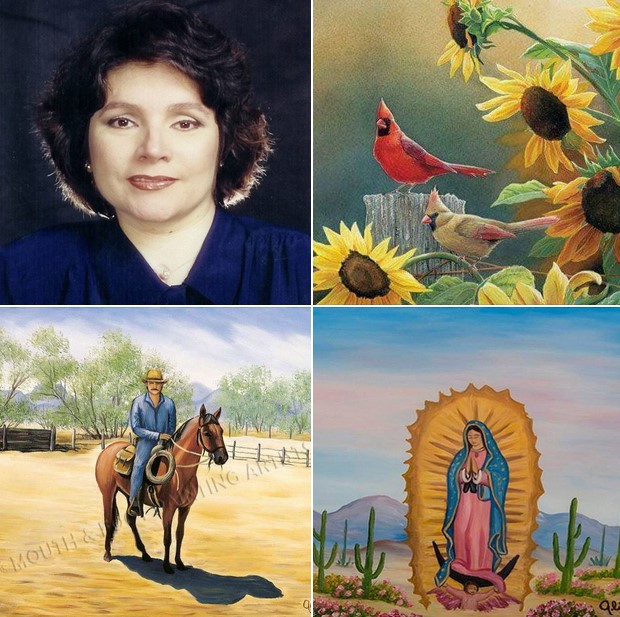
Nilda Alina Trevor Pino (1964 - 2018)
December 30, 2018
World-famous artist Nilda Alina Trevor Pino (1964 - 2018) has joined Padre Kino on the trail. She died after a long term illness. Alina is known for her beautiful paintings including landscapes of her beloved Sonoran Desert. At age 17, Alina was hit by a car while walking to school that left her paralyzed from the neck down. After the accident she started painting full time. Her paintings have been exhibited world-wide including 13 of her paintings of the Kino Missions that are on permanent display at the Kino Museum & Cultural Center in Segno, Trento, Italy. Alina is also known as an accomplished poet, an advocate for the disabled and children. "May the angels lead you into paradise ... may you have eternal rest." More about Alina's life well lived at the website of the Mouth & Foot Painters Artists: https://www.imfpa.org/artist-454
December 30, 2018
#padrekino
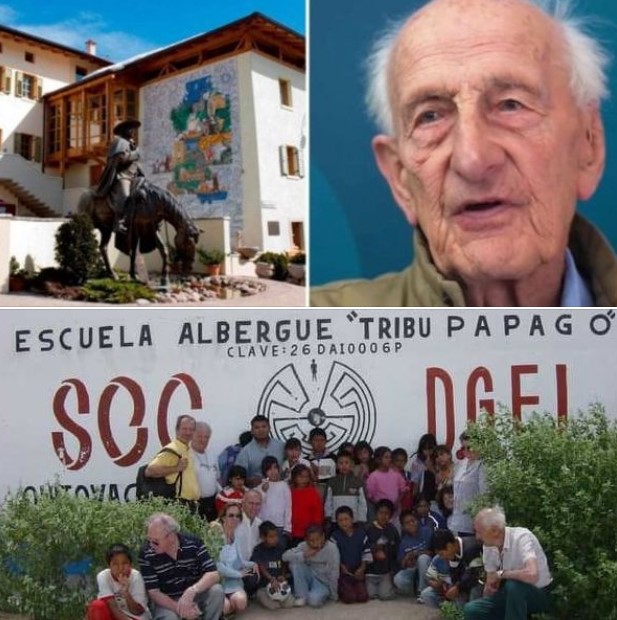
Silvio Chini (1928-2020)
November 3, 2020
Silvio Chini (1928-2020) - Life Long Promoter of Padre Kino's Life and Legacy. Silvio died peacefully at age 92 on October 31, 2020 - joining his beloved Padre Kino on the trail. Like Padre Kino, Silvio was committed to bettering the lives of others through his work in commerce, government and charities. Silvio's commitment to service was recognized in 1977 when the president of Italy made him a member of the Italy's Ordine al Merito del Lavoro (Order of Merit for Labour). Silvio was one of the last surviving members of the world's greatest generation who rebuilt and united Europe in peace after living through the horror and devastation of World War II.
In 1992 Silvio began his 17 years as the 1st president of the Padre Eusebio F. Chini (Kino) Cultural Association,. He led many Kino projects including the building of its museum in Segno.
Silvio guided many trips to Sonora and Arizona taking with him people from Kino's home province of Trent. These trips created today's enduring friendships among the people of Italy, Mexico and the United States.
More about Silvios's life at the Chini Cultural Association website (in English) at http://www.padrekino.org/in http://www.padrekino.org/en/. See also Nos Magazine Online (in Italian) at https://www.nosmagazine.it/rubrica/0/0/attualita.html
November 3, 2020
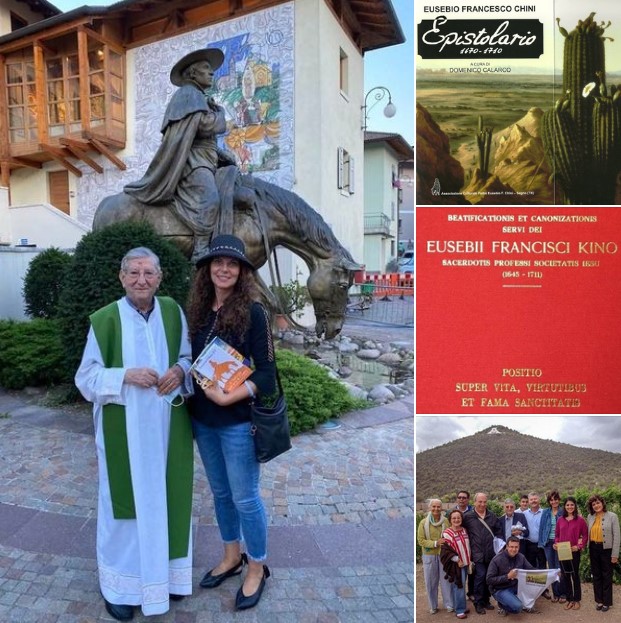
Padre Domenico Calarco, S.X. (1928-2022)
January 23, 2022
The Kino Community Remembers The Life of Padre Domenico Calarco, S.X. (1928-2022) - Vice-Postulator of The Kino Sainthood Cause, Kino and Missiology Scholar. "Dear Domenic, 'May the angels lead you into paradise ... may you have eternal rest' as you join Padre Kino on the trail. You will always remain in our hearts."
"Please call me Domenic" Padre Calarco would say when he was first introduced to a new person. The Kino community was very fortunate to know Domenic personally as a priest and friend. He was kind, very smart but without pretense. He was down-to-earth like Padre Kino - a priest that was approachable and had that missionary openness to all people. Domenic was a member of Xavierian Missionaries (Xaverians) (Missionario Saveriano in Italian), an international order of Catholic priests and nuns and affiliated lay persons who work with the poor and oppressed throughout the world in 21 countries. They teach and also provide economic aid to these communities while creating friendships that deepen their own spirituality and that of the people they serve.
Indeed, the Kino community was most fortunate to know Domenic professionally in its mission to have Eusebio Francisco Kino, S.J. (1645-1711) named formally as a saint of the Roman Catholic Church. Domenic was a Kino scholar since the 1990s and was a known expert in the history and practice of missiology. In November 2009, at age 81, Domenic was appointed by the Vatican as the vice-postulator of the Kino sainthood cause and was the cause's representative in Rome. As vice-postulator Domenic helped guide with incredible effort and speed, Kino's sainthood cause through the rigorous judicial process required by the Roman Catholic Church. With his editing of the first Kino "positio" and its submission, the Kino sainthood cause fulfilled the 2nd step toward canonization - the Pope declaring Kino as Venerable.
The first positio ( Positio - "Super Vita, Virtutibus Et Fama Sanctitatis" or Statement On the Life, Virtue and Holy Reputation) is the written petition to the Vatican that contains a biography of Kino and the reasons for Kino's canonization. It was submitted to the Vatican in November 2016. The positio was over 750 pages. The positio did not include the over 150 pounds of supporting documentation that was considered before by the Vatican's historical documentation subcommittee. The documentation was delivered to the Vatican in 2006 by the Archdiocese of Hermosillo and the cabalgantes of Por Los Caminos de Kino. For over 30 years Por Los Caminos de Kino made annual cabalgatas (pilgrimages on horseback) in honor of Padre Kino and retraced Kino's horseback rides on trails in Sonora and Arizona.
After the Vatican investigated Kino's life for heroic virtue and reputation for sanctity and reviewed the positio, Pope Francis in July 2020 declared Kino as Venerable. The practical effect of Kino's cause fulfilling the venerable stage is that the Roman Catholic Church is formally recognizing Kino as "a saint on paper."
Now what remains only for Kino to be named a saint is the verification of two miracles caused by prayers made to Kino requesting his intercession. Another positio will be submitted to the Vatican to as verification of Kino's intercessory first miracle and if accepted by the Pope will result in Kino being named a blessed. The last step in the canonization process is the submission of additional positio as verification of the second intercessory miracle and if accepted by the Pope, Kino will be named a saint. Either miracle requirement can be waived by the Pope.
Kino's cause for sainthood began immediately after his grave with his skeletal remains was discovered in today's Magdalena de Kino, Sonora in May 1966 by an international team of scholars and cronistas including archeologists, physical anthropologists and historians from Mexico's Instituto Nacional de Antropología e Historia (INAH) (National Institute of Anthropology and History) and the Arizona State Museum and University of Arizona. The first stage of the sainthood investigation officially began with the Vatican in May 1972 in the local diocese where Kino died - the Archdiocese of Hermosillo. Based on the results of the Archdiocese's investigation, Kino was named a Servant of God by the Vatican in 1998 completing the first stage.
Domenic was born in Calabria and lived there as a teenager during World War II. He was ordained a priest in the cathedral of Reggio Calabria on 9 October 1955. In his early years as a priest he taught literature. Later he was assigned as editor of various Xavier Missionary publications, serving in Italy, Scotland and the United States. In 1972, Dominic received from the Pontifical Gregorian University in Rome his license in missiology with a specialization in the study of spiritual traditions that are not based on Christian religions. In 1991, the Pontifical Gregorian University awarded him his doctorate in Missiology. Missiology is the academic study of the Christian mission history and methodology.
Domenic served in various capacities in Italian organizations concerned about the work of missionaries around the world. Domenic was also the historian of his religious order. He wrote official biographies of his fellow Xavierians. Fourteen Xavierians have been murdered during the 120 years that the order has been in existence. Throughout history missionaries were murdered because of their role as the conscience to the world and their witness to injustice, violence and other atrocities committed against the poor and oppressed people they serve.
Domenic died on January 13, 2022, at age 93 in Rome, isolated from his family and friends due to Covid Omicron Pandemic restrictions. He was recovering from surgery two months before that fixed his broken femur.
Domenic's scholarship about Kino began with the publication of his 1995 "L' apostolo dei Pima. Il metodo di evangelizzazione di Eusebio Francesco Chini, missionario gesuita, pioniere delle coste del Pacifico (1645-1711)" ("The Apostle to The Pima: The Method of Evangelization of Eusebio Francesco Chini, Jesuit Missionary, Pioneer of the Pacific Coasts (1645-1711)" in English translation).
A selected list of Domenic's other publications on Kino and missiology is at
https://centro-documentazione.saveriani.org/.../autori/50... are online on
On the same web page is a resume list of his lifetime of service to others.
Online is Domenic's book "Eusebio Francesco Chini Epistolario 1670-1710" (2014). The entire book in pdf format can be downloaded at
https://centro-documentazione.saveriani.org/.../21.pdf
Domenic collected, translated and edited 95 of Kino's letters into Italian with explanatory footnotes. Originally Kino primarily wrote these letters in Spanish with some written in Latin and a few in Italian. His book is a major contribution to Kino scholarship and was an important part of the documentation submitted in support of the Kino positio.
The text online of the homily delivered by fellow Xavierian Padre Luigino Marchioron, S.X. at Domenic's Mass of the Resurrection on January 15, 2022 in Rome ("Ricordando P. Domenico Calarco January 14, 2022") is at
https://dg.saveriani.org/.../ricordando-p-domenico-calarco
More information about Padre Kino's sainthood cause is at
http://padrekino.com/kino-heritage-society/cannonization/
January 23, 2022
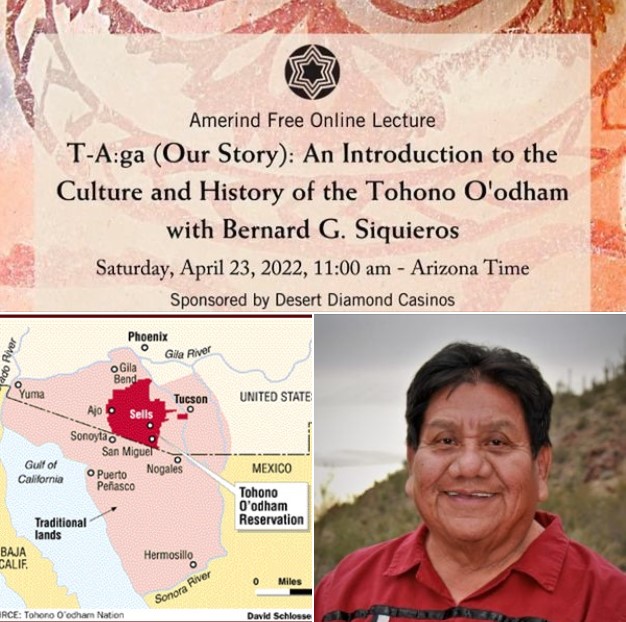
Bernard G. Siquieros (1950-2024)
June 20, 2024
Honor Bernard G. Siquieros (1950-2024) - "Helper To Others In Fulfilling Their Dreams" - and Celebrate The 17th Annual Anniversary of The Himdag Ki - The Tohono O'odham Nation Cultural Center & Museum - This Saturday, June 15, 2024. Festivities Begin at the Himdag Ki at 10 AM in Topawa Arizona.
From the beginning vision of the Himdag Ki in 2001 to its opening in 2007, Bernard G. Siquieros oversaw the architectural planning and construction of the $15.2 million project. He also hired the team of staff members and continued on as the Center's Curator of Education until his retirement in 2019. Bernard was generous and tireless as a promoter of education and the understanding of Arizona's cultures. More about Bernard's life and work below at the title "Bernard G. Siquieros - Helper To Others In Fulfilling Their Dreams"
More information about the The 17th Annual Anniversary of The Himdag Ki at
https://www.facebook.com/permalink.php?story_fbid=pfbid02Z2Gmdg9wsPZAjpHo4bwhosSjmYtqNyabBEPdSYKgnrAXz5KZFd3rMhS1tf3RT9Tel&id=100068590457194
___________
"BERNARD G. SIQUIEROS - HELPER TO OTHERS IN FULFILLING THEIR DREAMS"
Bernard G. Siquieros Whose Life Was Dedicated To Helping Others Fulfill Their Dreams In The Fields of Education and Cultural Understanding For The People of His Tohono O'odham Nation and State of Arizona.
While thinking about Bernard's many faceted roles as a community leader and Bernard's many living legacies, the motto of Bernard's beloved Tohono O’odham Community College (TOCC) immediately comes to mind. The College's motto in the O'odham Language is “Ñia, oya g t-taccui am hab e-ju” (informally translated into English as "Our dream fulfilled").
Bernard worked as a fulfiller of the dreams of others throughout his life in the fields of education and cultural understanding. He helped others fulfill their dreams by being a mentor to those who were fortunate to work with him. He fulfilled the dreams of others by serving in leadership roles at many institutions and organizations, including being a member of the Board of Trustees of TOCC and the Education Curator of the Himdag Ki: The Tohono O’odham Nation’s Cultural Center & Museum.
Bernard was a founding member of the Board of Trustees of the Tohono O’odham Community College (TOCC), a public tribal land grant college. Bernard generously volunteered his help with the College's accreditation, development of its main campus buildings, and recruitment of its faculty, staff, and students. He had just recently retired from the Board of Trustees in 2023.
The TOCC with its main campus near Sells, Arizona, and 3 satellite campuses including one in Phoenix and its nationwide online courses serves 900 students, primarily members of the Tohono O’odham Nation. Free tuition is provided for all Native American students living in the United States who can provide proof of tribal enrollment. Other students desiring to pursue higher education are welcome to attend with the payment of tuition. For all students attending TOCC, both Native American and non-Native American, text books and other college fees are free - paid for by governmental grants. TOCC truly lives up to its motto: “Ñia, oya g t-taccui am hab e-ju” ("Our Dream Fulfilled). More about TOCC at https://tocc.edu/.
Bernard G. Siquieros was an enrolled member of the Tohono O’odham Nation. He was born in San Xavier on the Tohono O’odham Nation near Tucson, Arizona and lived in Cover Wells.
Bernard's was a fulfiller of dreams by helping others achieve their own dreams through his roles as an educator, mentor and team builder. He began his career as a guidance counselor and coach to Tohono O’odham students for 10 years. Afterwards he worked for 6 years as the Director of Education of the Tohono O’odham Nation's tribal government and then directed Prescott College's Center for Indian Bilingual Teacher Training.
From the beginning vision of the Himdag Ki: The Tohono O’odham Nation’s Cultural Center & Museum in 2001 to its completion in 2007, Bernard oversaw the architectural planning and construction of the $15.2 million project. He also hired the team of staff members and would continue on as the Center's Curator of Education until his retirement in 2019.
During his lifetime Bernard recorded the O'odham and their Himdag (O'odham values, culture and way of life) through his accomplished photography and his many presentations about the O'odham people. Bernard's photos of the O'odham people's everyday life and celebrations are on exhibit at the Amerind Foundation through October 31, 2024.
Bernard was nationally recognized when he was named as an American Indian Community Curator for the Smithsonian's National Museum of The American Indian (NMAI). He was part of the team that developed the Tohono O’odham exhibition at NMAI’s grand opening.
Bernard was generous and tireless as a promoter of education and the understanding of Arizona's cultures. He presented and participated at many events sponsored by community organizations and institutions throughout Arizona such as the University of Arizona, Arizona-Sonora Desert Museum, Tucson Meet Yourself, Amerind Foundation, Tohono Chul Botanical Gardens and Tucson Medical Center.
A very small remembrance of Bernard's lifetime of work can be viewed online for free on YouTube at https://www.youtube.com/watch?v=-6RtXu_wHnA. Bernard's talk was recorded at the Amerind Foundation in Spring 2022 and is entitled "T-A:ga (Our Story): An Introduction to the Culture and History of the Tohono O’odham."
And what would Bernard think about this post about his life and work. Eric J. Kaldahl, President & CEO of the Amerind Foundatiion wrote on January 12, 2024 in a letter to the Amerind's email subscribers: "As I think about some of the amazing accomplishments of Bernard Siquieros—I know he would be the first to say that every project he worked on benefited from a team of hard working, caring people. He would humbly turn the spotlight toward others. Nonetheless, his inspiring leadership brought out the best in those teams of people and led them to do great things. When seeking someone who can get a complex job done well—Bernard was the leader you wanted."
You can read more about Bernard's life in an obituary at https://www.jwarrenfuneral.com/obituaries/bernard-siquieros. Our deepest condolences to his family and his friends and community.
Ñia, oya g t-taccui am hab e-ju” (Our Dream Fulfilled) sums up the many living legacies that Bernard G. Siquieros helped create as The Fulfiller of The Dreams of Others as his beloved Tohono O'odham Community College proclaims in its school motto. #padrekino
June 20, 2024
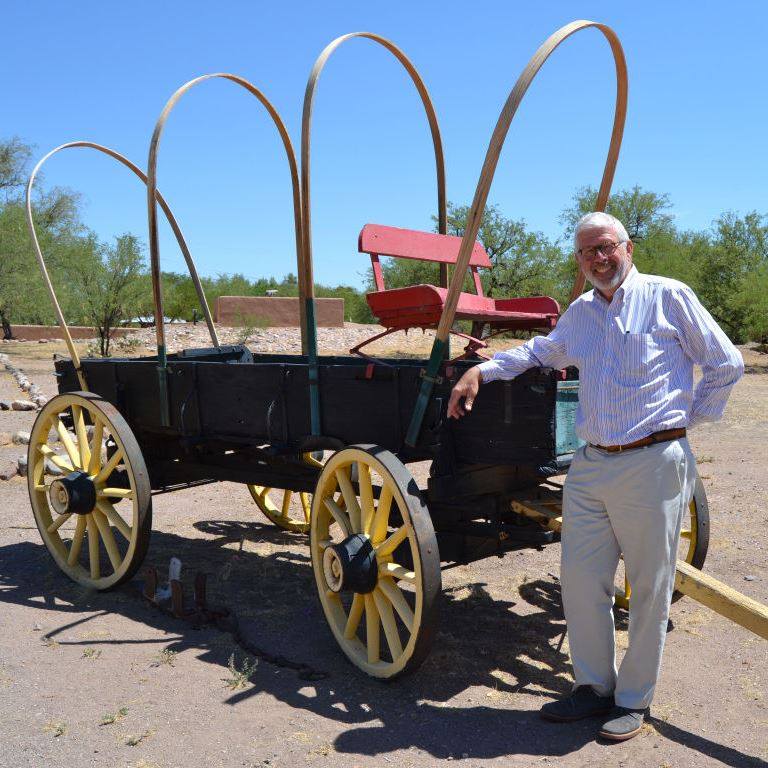
Shaw David Kinsley (1947-2017)
July 8, 2018
Shaw David Kinsley (October 6, 1947 - July 6, 2017) left behind a significant legacy having been the Director of the Tubac Presidio State Historic Park since 2010. His love of history led him to rescue the first Arizona state park from closing its doors. By recruiting volunteers and keeping them dedicated with his leadership and charismatic personality, Shaw was able to maintain and expand the park to become a major Tubac destination. Shaw was the recipient of the Arizona Historical Society Al Merito award that recognizes individuals who have made outstanding contributions and served as role models for preserving Arizona's rich history.
Shaw was born as an only child to the late Wynn Kinsley from Oregon and Faith Anderson Kinsley from New York, in Denver, Colorado. His beloved partner was the late Michael Wolfarth of Tucson and New York City. He graduated high school from Taft School in Watertown, Connecticut, Bachelor of Arts from the University of Colorado, Library Science from the Pratt Institute, Masters of Science from the University of Oxford. He was an Army drill sergeant and in the reserves from 1968-1974. Among his many accomplishments, he worked at the Center for Creative Photography, University of Arizona from 2000-2005. For several years, he was heard on Tucson's classical music radio station KUAT. Shaw was a member of the Order of St. John of Jerusalem also known as the Order of Malta and numerous organizations.
July 8, 2018
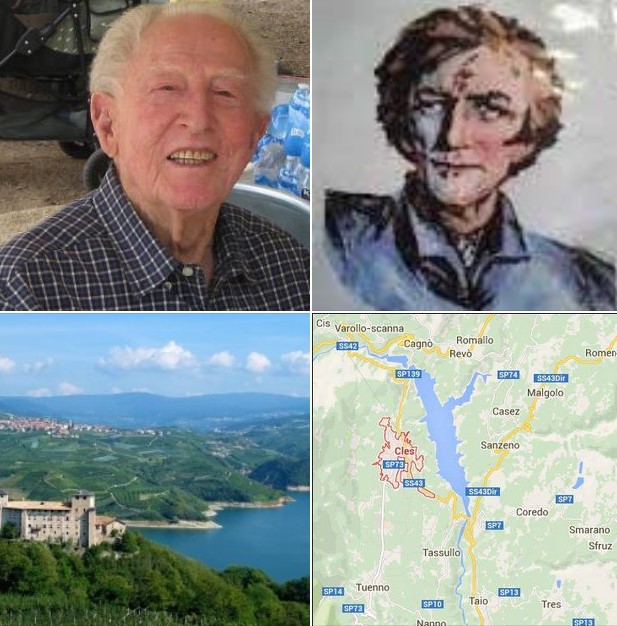
Lino DeConcini (1921-2015)
March 20, 2015
Lino DeConcini (1921-2015) has joined Padre Kino on the trail. Lino died on February 24, 2015 and his Mass and Rosary are today March 20th. Lino helped Padre Kino's sainthood cause in many ways including having scholars from Italy stay at his Tucson home while they did research about Padre Kino in Arizona and in Sonora. Both Lino and Padre Kino were born in the Val di Non in the Italian province of Trentino and both lived and worked in the Sonoran Desert. Lino was born in Casez just north of Padre Kino's village of Segno. Vaya con Dios, Lino. More about Lino's life at https://www.tributearchive.com/obituaries/10681996/lino-de-concini
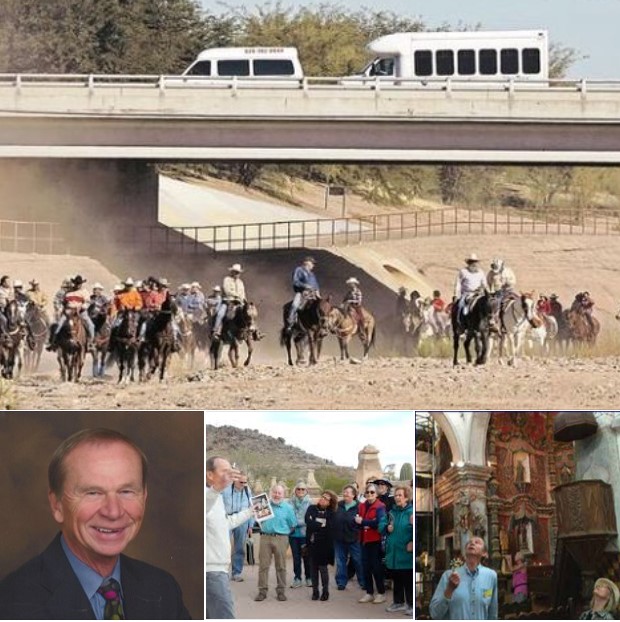
Stanley Maliszewski (1945-2019)
June 24, 2019
Un Verdadero Pimalteño Stanley Maliszewski (1945-2019) has joined Padre Kino on the Trail. Stan & Judy found their home 20 years ago in the Pimería Alta when Stan became a University of Arizona professor of educational psychology. Then Stan & Judy found horseback riding & Stan became an expert in the field of Equine Assisted Mental Health. Also Stan lead the docents of the Patronato San Xavier (http://www.patronatosanxavier.org/) who annually guide for free over the 25,000 visitors at Mission San Xavier del Bac. Stan's funeral Mass is at his beloved querencia - Mission San Xavier del Bac - on Thursday morning, July 25, 2019 at 10:00 a.m. Tucson. Ernesto Portillo featured Stan (riding center) in his column on the 2008 cabalgata (pilgrimage on horseback) to the Mission San Xavier del Bac at https://tucson.com/news/local/neto-s-tucson-by-ernesto-portillo-jr-horseback-pilgrims-find/article_f6f2ca48-7239-5dc6-a081-1eaed97fd798.html?fbclid=IwY2xjawE4lX1leHRuA2FlbQIxMAABHe0ncPsgm0WugSc9TXaGpQlgiVpJtw6n10cLnt4W55xbNNCaucfH3ZEeZg_aem_b2sO0RqowKVfY6olG-_15Q
June 24, 2019
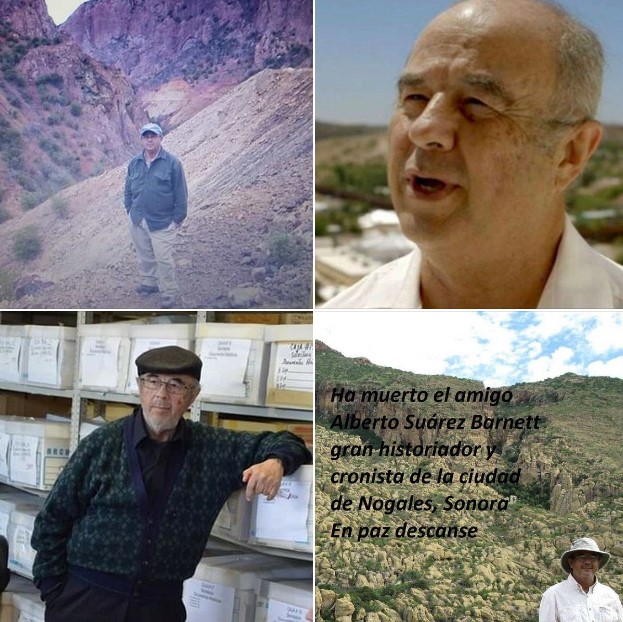
Fernando Alberto Suárez Barnett (1948-2019)
June 9, 2019
Fernando Alberto Suárez Barnett (1948-2019) - The Pimería Alta's Great Cronista. Alberto has joined Padre Kino on the trail. Officially the named municipal cronista of Nogales, Sonora from 2000 to his recent death, Alberto also was recognized as "a historian's historian" by both academic & community historians. His knowledge of the Arizona-Sonora region was encyclopedic. He loved his native land & the research in its archives & in the field. Alberto viewed history both qualitatively as a modern Renaissance man & quantitatively as an engineer. He generously shared his knowledge in his talks, newspaper articles & weekly blogs and with other historians. He believed in the power of living history - that understanding the past may lead to a better future. More about Alberto's life at http://www.eldiariodesonora.com.mx/notas.php?nota=130173
June 9, 2019
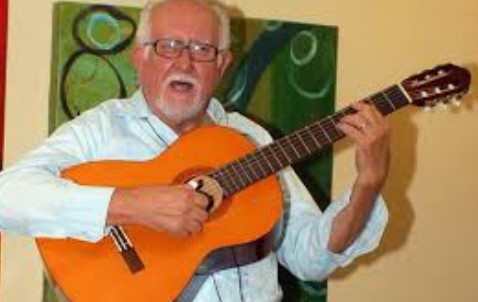
Robert L. ('Bobby') Benton (1938-2019)
March 30, 2019
Tucson's Troubadour of Song and Goodwill Robert L. ('Bobby') Benton (1938-2019). Bobby has joined Padre Kino on the Trail. Bobby's friendliness along with the sounds of his magnificent voice and guitar brought joy to the people of Tucson at its private gatherings and civic and religious celebrations. Bobby's passion for music was only surpassed for his love for his wife Patricia and their family and many friends. Visitation - Sunday, March 31, 2019 from 5:00 p.m. - 9:00 p.m. with Rosary at 7:00 p.m. Carrillo's Tucson Mortuary, 204 S. Stone Avenue; Mass of the Resurrection - Monday, April 1, 2019 10:30 a.m., St. Augustine Cathedral, 192 S. Stone Avenue, Tucson, Arizona. More about Bobby's life well lived with one of his song's "La Carcel de Cananea" at https://www.facebook.com/david.benton.507/videos/2277826818904050/?t=79
March 30, 2019
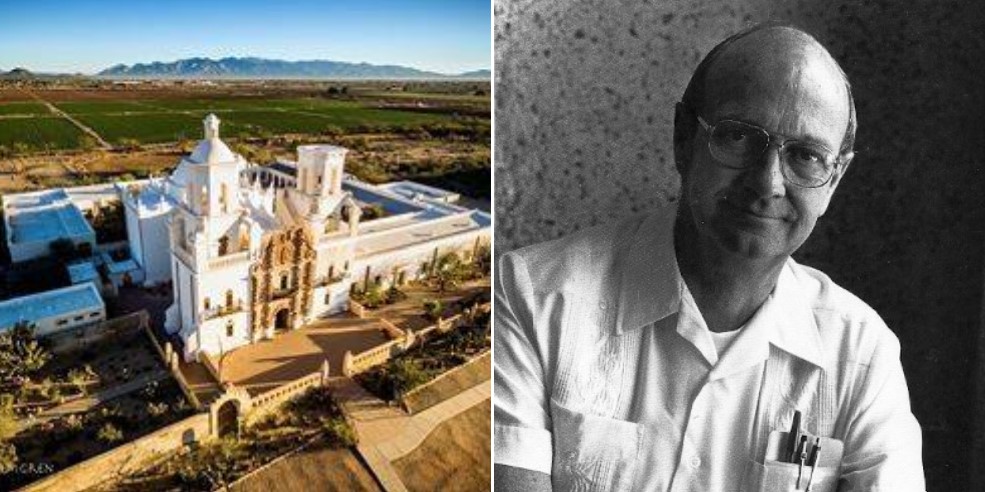
Dr. Bernard L. "Bunny" Fontana (1931-2016)
April 7, 2016
Dr. Bernard L. "Bunny" Fontana (1931-2016) Few could match Bunny's great love of the Pimería Alta - its land and its people - past and present. Today Bunny joined Padre Kino on the trail.
Bunny's article in the November 1986 issue of Arizona Highways shows his great humanity for the people that he met throughout his own life's journey. Peregrinos will travel to San Xavier del Bac this Friday morning to honor the memory of this great maestro. Buen Camino Bunny.
"Pilgrimage to Mission San Xavier del Bac"
Dr. Bernard L. ("Bunny") Fontana (1931 - 2016).
[Beginning of Article]
"To become a pilgrim is to embark on an adventure, to leave the comfort and security of one's home, neighbors, and familiar surroundings as an act of faith. It can be motivated by the need to do penance. It may be inspired by a sense of thanksgiving. It can be a sacrifice offered in petition.
A pilgrimage must, however, have a sacred place as its goal.
The tradition of pilgrimage is as old as organized religion. And the custom is alive and thriving in southern Arizona where Mission San Xavier del Bac, founded in 1700 by Jesuit missionary Eusebio Kino, has become the magnet for peregrinos, pilgrims, who walk to the mission, hundreds of them each year.
The journey has to be on foot. Driving or riding doesn't count.
The Mission San Xavier we see today was built by Franciscans between the late 1770s and 1797. It is the parish church for Papago Indians who live on the San Xavier Indian Reservation; it is one of Arizona's most popular tourist attractions; and, beginning possibly as early as the last century, it has become a center of pilgrimage for many of the region's Mexicanos or Americans of Mexican descent who are bearers of a Christian tradition rooted in antiquity.
The mission is located about nine miles south of downtown Tucson. On any day of the week, but especially on weekends, pilgrims make [their way south along Mission Road or east along San Xavier Loop Road toward the church. They walk singly, in pairs, trios, or in larger groups. Their heads are uncovered, or they wear wide-brimmed hats, baseball caps, or bandannas. A few wear the religious habit of a saint or sectarian figure. Some carry umbrellas. They may carry water bottles and be without visible logistical support. Or they may walk ahead of a car or truck that will park, then catch up again every few hundred yards. They walk unaided, although some use walking sticks, canes, even crutches.
The pilgrims are of all ages: young children who are hardly more than toddlers, boys and girls, young men, women - some with babies in arms - middle-aged, and elderly. Some stand erect; others are stop shouldered. Some walk briskly; others, idly, playing as they go and aiming rocks at rabbits or birds in the brush beside the road; still others shuffle along, painfully determined to make it all the way to their destination. There are those who laugh, smile, and talk. There are those whose countenances are grim, sad, or reflective and who say little or nothing.
They share a common goal. It is to cover the miles on foot to Mission San Xavier del Bac and, once there, to give thanks to God through one of the saints for a blessing received or to petition for a blessing desired.
For some, the walk is not enough. A few elect to give further evidence of their devotion and added meaning to their sacrifice by going the length of the nave or sometimes all the way from the gate at the atrium in front of the church - on their knees. Fewer still throw themselves flat before the high altar.
Many light votive candles in honor of a particular saint (more than three dozen are represented inside the church by images sculptured in the eighteenth century). Many more affix small metallic votive offerings (milagros), usually in the shapes of afflicted body parts, to the coverlet over the reclining statue of San Francisco lying on an altar in the west chapel.
The majority of these pilgrims are carrying out the terms of a vow (manda) made to God through the intermediary of a saint. Others make straightforward requests.
Notes left beneath burning votive candles in the mission's mortuary chapel during a typical month tell part of the story:
"As que me rínda el dinero St. Lazaro." (Make my money stretch, Saint Lazarus).
Or another in translation: Fairest sainted child Atocha [i.e., Christ who appeared as a child and aided the Christians at the time of the Moorish invasion of Atocha, Spain], we give you thanks for all the favors that we have received from you daily. Thank you, adored Child of Atocha, for having helped my little son J. ···· with his left hand and for his having come out of his two operations well and able to use his little hand Many thanks to you. Child of my heart. I promised to dress him like you and I fulfilled my promise for three months, and now I offer you his habit (a beautifully hand-sewn tunic and cape) in the name of my son J…From now on, you will be his advocate; so take of care him, protect him, and guide him on the right path now and forever. Thank you for your miracles and blessings, sainted Child of Atocha.
And in English, written on the back of a voided personal check: Dear God - I am in so much trouble with the law. Please help me be strong and give me thoughts to help me and my family and friends who are going through this. I'm begging you to please help. I don't want to go to prison. And I don't want to be scarred for life. God help me be out of this and let all this be over real soon.
With nearly equal anguish: Dear Sweet Jesus, Sacred Heart. Here I am asking you please to help me in my life, help me with my divorce. Please!
Don't let me hurt anybody! Help me make a better future for me and my kids. I promise to try very hard. Please be with me all the way. Please help my husband not to hurt so much. Help him, please.
Forgive me my sins. Have mercy on me.
Thank you for every blessing you have given us. Please be with me. Give me strength.
I love you.
And most poignant of all: St. Anthony. Please give my baby back. Please.
Pilgrimage. An act of faith, an expression of deeply held religious convictions. And famous, beautiful Mission San Xavier del Bac is the goal. It is a holy place in which to receive affirmation of one's innermost sentiments, whether of penance, thanksgiving, or petition- a place that provides beauty to the eye and sustenance for the soul."
[End of Article}
Dr. Bernard L. Fontana
"Arizona Highways"
November 1986
Link to original article with text and pictures for "Pilgrimage to San Xavier" by Dr. Bernard L. ("Bunny") Fontana (1931 - 2016) starting at page 24 is pdf copy of Bunny's article in the Arizona Highways November 1986 issue at
https://azmemory.azlibrary.gov/nodes/view/37202
Buen Camino Bunny!
April 7, 2016
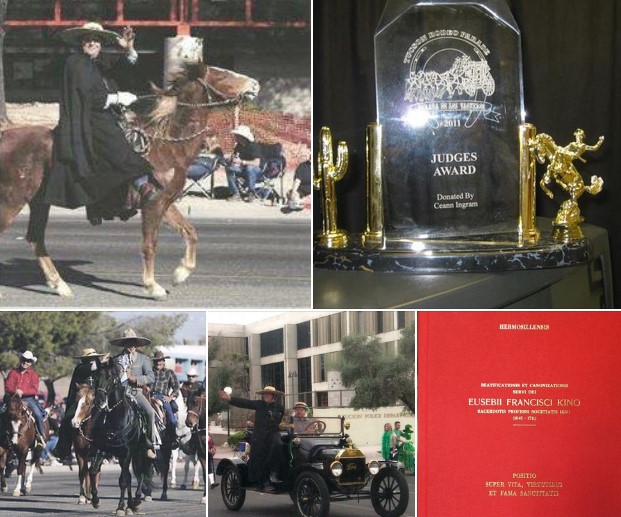
Charles DeConcini (1947-2024)
June 1, 2024
† CHARLES DeCONCINI (1947-2024) † Padre Kino's Representative in Tucson's 2011 Rodeo Parade and St. Patrick's Parade, Grade School Contributor To Kino's Sainthood Cause, and Son of Immigrant Born 5 Miles From Kino's Birthplace.
Last week Charles DeConcini joined Padre Kino on the trail. Cancer took Charles DeConcini's life - a life full of vitality.
In 2011, when it was suggested that someone represent our Padre on Horseback in the Tucson Rodeo Parade, Charles immediately came to mind. When asked, Charles accepted with his usual enthusiasm.
The year 2011 was more important than other years when Padre Kino had his customary presence in the Rodeo Parade. The year 2011 marked the 300th year anniversary of Kino's death. The Rodeo Parade would be a fitting start for a year full of commemorative events. As historian Hebert Bolton wrote of our Padre on Horseback, "Kino's endurance in the saddle would make a seasoned cowboy green with envy."
Like Padre Kino, Charles was an accomplished rancher and an excellent horseback rider - skills he acquired from years working with cattle. Like Kino, Charles was a builder, with a career in the construction industry as a general contractor.
And like Kino, Charles had Val di Non roots. Charles's father, Ettore DeConcini, was born in the Italian Alps 5 miles north of Kino's birthplace of Segno. As part of the worldwide diaspora of people born in the province of Trent, Ettore DeConcini immigrated to United States before the beginning of World War II. And like many immigrants, he served in the US armed forces in America's fight against the Axis Powers and their global tyranny of murder and slavery.
In the 2011 Tucson Rodeo Parade, Charles represented our Padre on Horseback and rode a Spanish Barb horse from the ranch of Marjorie Dixon. He was escorted by 30 Kino Vaqueros (top and bottom left pictures) called to ride by Josephina Cardenas.
"Padre Kino and His Vaqueros" was the largest 2011 parade entry of horseback riders and "Padre Kino and His Vaqueros" won the Tucson Rodeo Parade's Judges' Award (top right picture).
Three days before celebrations on the actual March 15th anniversary date of Kino's death, Charles stood-in for Padre Kino as the Honorary Co-Grand Marshall of Tucson's annual St. Patrick Day Parade (picture bottom right). Kino was honored as Grand Marshall because, like Saint Patrick, the missionary to Ireland, Kino also fought against slavery.
Charles told me a story that when with the happening of later events would have greater significance. I wish I would have had a chance to talk about its significance before he died.
In the late 1950s, the great historian Father Bonifacio Bolognani (1915-2000) traveled to Tucson to do research on Kino's life. Father Bonifacio would stay with Charles' family. In order that Father Bonifacio had a place to organize his research, write and sleep, grade school aged Charles gave up his bedroom. Charles would sleep on the couch in the living room but he did not mind. He told me that Father Bonafacio was a "very cool person" and he was "good to have around."
Now fast forward from the late 1950s in Tucson to 2016 in Rome at the Vatican. It has been almost half century since Kino's sainthood cause began in the Archdiocese of Hermosillo. With great effort in Mexico and Italy, the Kino Positio is published and presented to the Vatican in 2016. The Kino Positio is a series of documents including all of Kino's writing, affidavits supporting Kino's reputation for sanctity and other evidence translated into Italian to support the formal recognition of Padre Kino as a Catholic saint. It is based on150 pounds of written material concerning Kino that was delivered to the Vatican ten years earlier. Fully incorporated as the key biographical section of the Kino Positio is Father Bonifacio's 1962 Kino book based on his Tucson research made a little easier by young Charles DeConcini.
The approval of the Kino Positio was accelerated at warp speed by usual Vatican standards and in 2022 Pope Francis gave Padre Kino the title of venerable. In essence, Pope Francis by naming Kino venerable made Kino a saint on paper. The formal recognition of Kino as "Blessed" is by verification of a first miracle and then the recognition of Kino as "Saint" by verification of the second miracle. Pope Francis can waive the miracle requirements. In the hearts of many, Padre Kino is already a saint.
In most sainthood causes, especially in the case of Kino's cause, every contribution mattered. It mattered for the Kino cause that a grade school child gave up his bedroom and then 40 years later at age 62, rode as the Padre on Horseback.
Thank you Charles for helping our heroic padre, and, as you join Padre Kino on the trail, "May the angels lead you into paradise ... may you have eternal rest."
#padrekino
June 1, 2024
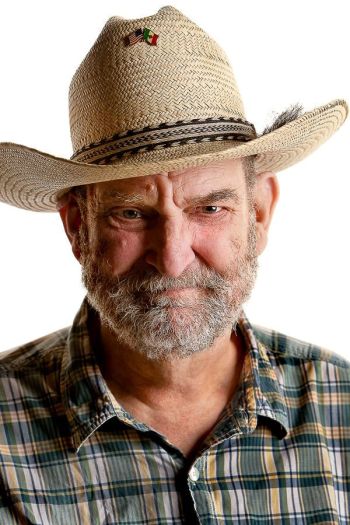
Dr. James S. ("Big Jim") Griffith (1935-2021)
December 19, 2021
Dr. James S. ("Big Jim") Griffith (1935-2021) - Un Verdadero Pimalteño, died December 19, 2021, joining Padre Kino on the trail. Jim was "un verdadero Pimalteño" or a true Borderman. He was happily at home in the many cultures and varied landscapes of our own Borderlands and the world beyond. His many friendships cast a very wide net over humanity in all walks and stations of life. Read about Jim's well-lived life on the website of the National Endowment for the Arts (NEA) when he was honored in 2011 with the National Heritage Fellowship and the Bess Lomax Hawes award for his "significant contribution to the preservation and awareness of cultural heritage." These awards are the most prestigous awards that a folklorist and anthropologist can receive. Link at https://www.arts.gov/honors/heritage/jim-griffith. The portrait photograph of Jim wearing his flag pin with the flags of United States and Mexico on his hat joining its people in solidarity is by Steven Meckler. "May the angels lead you into paradise ... may you have eternal rest."
December 19, 2021
Big Jim Griffith says we should remember Kino whenever we eat a beef or chicken burro. Kino introduced most of the ingredients to our Sonoran Desert: tortillas from his wheat; meat from his cattle or chickens; cheese from his goats or diary cows. Don't forget his grapes for the Kino Vino.
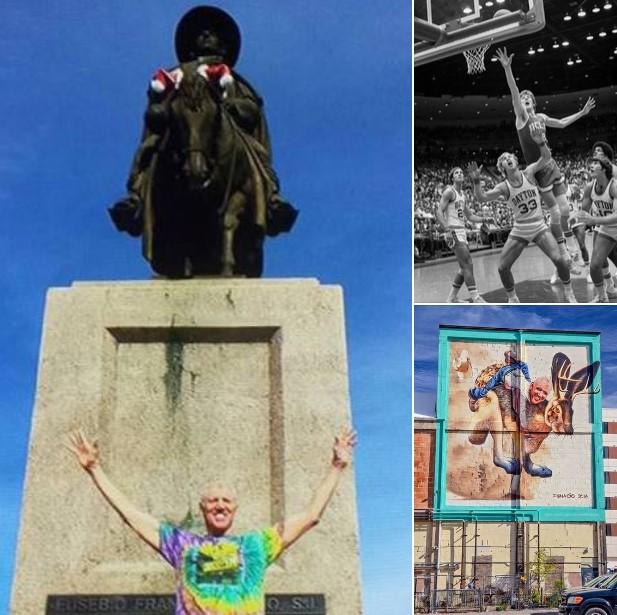
Bill Walton (1952–2024)
May 29, 2024
† BILL WALTON (1952–2024) † Padre Kino Aficionado - A Noble Person Who Just Happened to Be One of The Greatest Basketball Players of All Time.
Bill Walton gained fame as one of the greatest basketball players in the National Collegiate Athletic Association (NCAA) and the professional National Basketball Association. After retiring from basketball, Bill had a long career as a TV sports commentator.
Bill loved Tucson and would comment during his TV broadcasts about it's friendly people, rich culture and natural beauty. He experienced all first hand in his many visits to Tucson from his home in San Diego including riding his bicycle many times in the annual 100 mile plus El Tour de Tucson cycling event. And Tucson loved Bill - as shown by a fanciful mural in downtown Tucson on a three story building depicting Bill riding a leaping jackrabbit by artist Ignacio Garcia (https://www.ignaciotheartist.com/). (photo bottom right).
A truly memorable time on TV was when Bill talked at great length about his admiration of Padre Kino's life and work during his ESPN coverage of the University of Arizona vs Oregon men's basketball game in December 2016. During this Tucson visit, Bill, as as a Kino aficionado, trekked out to the Padre on Horseback Kino statue on Kino Parkway and had his picture taken by TV journalist Paul Cicala. The decorating of Kino's horse with ear muffs in early December is a Tucson Christmas tradition that begins the Christmas season. (photo left).
An early Tucson memory for Bill was during the 1974 NCAA tournament semi finals held at McKale Center. The two previous years Bill led his UCLA team to NCAA national championships. On the way to the third NCAA championship game, UCLA (University of California Los Angeles) defeated Dayton 111-100 in three overtime periods. A photograph of Bill leaping over the Dayton team was taken by then University of Arizona student H. Darr Beiser who went on to become a photojournalist for USA Today documenting major news events around the world for three decades. Now Darr continues his work as an independent photographer and video producer in the Washington, D.C. area (https://hdarr.com/). (photo top right).
Bill would repeatedly say that in working towards being a better basketball player, one had to work on character first. Bill Walton deserves to be remembered as a noble person because building character was always first with him. He was a person of courage, generosity and high ideals.
Bill was always willing to help in any way he could on and off the basketball court. See Vince Rabago's post about Bill at https://www.facebook.com/.../pfbid0ofqSvsTEUw8GFKfkFfeVGU...
Dear Bill, as you join Padre Kino on the trail, "May the angels lead you into paradise ... may you have eternal rest."
#padrekino
May 29, 2024
William Theodore Walton III
